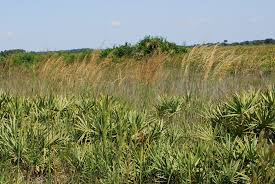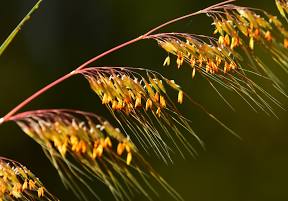Indian Grass, scientifically known as Sorghastrum nutans is a special kind of plant that grows in places like North America, which is where countries like the United States and Mexico are. It looks really nice and helps nature in many ways.
This plant is not like the ones that grow just for a little while. It sticks around for a long time. It has tall stems that can be even taller than a grown-up person. The leaves of the Indian Grass are slim and a bright green color. When you see a bunch of them together, they make a big group that moves gently when the wind blows. That looks really cool!
What’s even more interesting is the flowers on the Indian Grass. They come out in late summer and stay until fall. These flowers are not like the big colorful ones you might think of. They are soft and feathery, like tiny fluffy feathers. When they grow up, they turn a warm gold color, which makes them look like they are shining in the sunlight.
This Indian Grass is like a hero for the ground. It has roots that go really deep into the soil. These roots help stop the soil from washing away when it rains a lot. So, it’s like the Indian Grass is holding the ground together and stopping it from getting hurt. Because of this, it’s an important part of places like prairies and grasslands.
Animals also really like the Indian Grass. Birds and insects find it to be a good home and a tasty snack. Bugs like bees and butterflies love to drink nectar from its flowers. It’s like a special restaurant just for them. Birds might make their nests in the Indian Grass and feel safe there.
A long time ago, people saw how strong the Indian Grass was. Native American tribes knew they could use it to make things like baskets and mats. They were clever and knew how to weave the stems together. Even the early settlers thought this grass was useful. They saw that animals liked eating it, so they used it to feed their own animals like cows and horses.
People today still like the Indian Grass. It’s pretty and doesn’t need a lot of taking care of. People put it in their yards and other places to make them look nice. This grass reminds us of the wild and natural world, even if we live in a city.
Additionally, Indian Grass is a special plant that stays around for a long time. Its tall stems, green leaves, and soft feathery flowers make it look really nice. It’s like a hero that stops the soil from getting washed away and gives animals a good place to live. People from a long time ago and people today all like the Indian Grass because it’s useful and beautiful.
Read Also: Effect of Tropical Climate on Animal Parasites, Vectors and Diseases
Growing and Care Guide of Indian Grass

Growing and taking care of Indian Grass is an enjoyable and rewarding experience. This guide will help you understand how to cultivate and maintain this beautiful plant in your garden or outdoor space.
1. Choosing the Right Location: Select a sunny spot for your Indian Grass. It loves sunlight and grows best when it gets plenty of it throughout the day.
2. Soil Preparation: Indian Grass prefers well-draining soil. Before planting, amend the soil with compost or well-rotted manure to improve its fertility and drainage.
3. Planting: Plant Indian Grass in the spring or early fall. Dig a hole slightly larger than the root ball and place the plant in the hole. Fill in with soil and tamp it down gently to remove air pockets. Leave enough space between plants, as Indian Grass can spread out as it grows.
4. Watering: Water newly planted Indian Grass regularly to help it establish its roots. Once it’s established, it is quite drought-tolerant and doesn’t need frequent watering. Water deeply rather than frequently to encourage deeper root growth.
5. Mulching: Apply a layer of mulch around the base of the plant to help retain moisture and suppress weeds. This is especially important during the first year after planting.
6. Pruning: Indian Grass doesn’t require much pruning. In late winter or early spring, you can trim back the dead stems to about 6 inches above the ground to make room for new growth.
7. Fertilizing: Indian Grass doesn’t need a lot of fertilizers. You can apply a balanced, slow-release fertilizer in the spring, but be careful not to over-fertilize as it can lead to excessive growth and weak stems.
8. Dividing: After a few years, Indian Grass can become overcrowded. You can divide the plant in the early spring before new growth starts. Dig up the clump, separate the sections, and replant them in their new spots.
9. Pest and Disease Control: Indian Grass is relatively resistant to pests and diseases. Keep an eye out for any signs of problems, such as discolored leaves or damage, and take action accordingly.
10. Attracting Wildlife: If you’re interested in attracting birds and insects, let the flower panicles stay on the plant through fall and winter. They provide food and shelter for wildlife.
11. Winter Care: Indian Grass adds interest to the winter landscape with its dried stems and panicles. You can leave them standing until early spring, when you can cut them back to make way for new growth.
By following these simple steps, you can successfully grow and care for Indian Grass in your outdoor space. Its beauty and ecological benefits will surely make it a valuable addition to your garden.
Read Also: Causes of Diseases in Farm Animals and How to Prevent Disease OutBreak
Benefits of Indian Grass

Here are seven good benefits of Indian Grass:
1. Erosion Control: The deep root system of Indian Grass helps prevent soil erosion. Its strong roots hold the soil together, reducing the risk of soil being washed away during heavy rains or wind.
2. Wildlife Habitat: Indian Grass provides shelter and food for various wildlife species. Birds, insects, and small animals find refuge in its dense clumps, and the nectar-rich flowers attract pollinators like bees and butterflies.
3. Drought Tolerance: Once established, Indian Grass is remarkably drought-tolerant. It can thrive in areas with limited water availability, making it a great choice for regions prone to dry spells.
4. Low Maintenance: Indian Grass is relatively low-maintenance once it’s established. It requires minimal watering and pruning, which makes it an ideal option for busy gardeners or those looking for an easy-care plant.
5. Native Plant Conservation: By planting Indian Grass, you’re contributing to the conservation of native plants. Using native species like Indian Grass in landscaping helps maintain local ecosystems and supports biodiversity.
6. Soil Improvement: As a perennial grass, Indian Grass contributes to soil health. Its decaying leaves and stems add organic matter to the soil, enhancing its structure and fertility over time.
7. Aesthetic Appeal: With its tall and graceful appearance, Indian Grass adds beauty and texture to landscapes. Its feathery flowers change color as they mature, providing visual interest from late summer through fall and even into winter.
These benefits showcase the value of Indian Grass not only as a decorative element but also as a functional and eco-friendly addition to gardens and natural areas.
Read Also: What You Should Know About Koosh Balls
